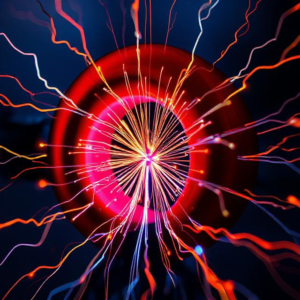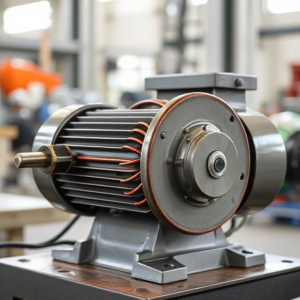What is Electromagnetism?
Electromagnetism is one of the fundamental forces of nature, and it deals with the relationship between electricity and magnetism. It’s the science that explains how electric currents and magnetic fields are connected and how they interact with each other.
In simple terms, electromagnetism shows us how electricity can create a magnetic field, and how a magnetic field can create electricity. This interaction is the foundation for many devices we use every day, like motors, generators, and even our phones.
Let’s break it down into key points for a better understanding.

Key Concepts in Electromagnetism
- Electricity and Electric Current:
- Electricity is the flow of tiny charged particles called electrons through a conductor (like a wire). This flow of electrons is known as electric current.
- Electric current is measured in amperes (A), and it’s what powers all electronic devices, like lights, computers, and phones.
- Magnetism:
- Magnetism is a force that acts at a distance, pulling or pushing certain materials (like iron, nickel, and cobalt).
- Magnetic fields are created by magnets, which have two poles: north and south. Like poles repel, and opposite poles attract.
- A magnetic field is an invisible area around a magnet where its magnetic force can be felt. It is measured in tesla (T).
How Electricity Creates a Magnetic Field (Electromagnetism)
One of the key discoveries in electromagnetism is that electricity can create a magnetic field. Here’s how it works:
- Electric Current and Magnetic Field:
- When an electric current flows through a wire, it generates a magnetic field around the wire.
- The magnetic field forms concentric circles around the wire. The direction of the magnetic field depends on the direction of the current.
- Right-Hand Rule:
- A simple way to remember the relationship between electricity and magnetism is the right-hand rule:
- Hold your right hand with the thumb pointing in the direction of the electric current.
- Your fingers will curl around the wire, showing the direction of the magnetic field.
- A simple way to remember the relationship between electricity and magnetism is the right-hand rule:
How Magnetism Creates Electricity (Electromagnetic Induction)
Just as electricity can create a magnetic field, magnetism can also create electricity. This is called electromagnetic induction, and it’s the principle behind devices like generators.
- Moving a Magnet through a Coil:
- If you move a magnet near a coil of wire, the magnetic field will change the electrons in the wire and cause them to move, creating an electric current.
- The faster you move the magnet or the stronger the magnet, the more electricity is generated. This is the basic principle behind how electric generators work.
- Faraday’s Law of Induction:
- The process of generating electricity by changing the magnetic field is described by Faraday’s Law of Induction. It states that the amount of electricity generated depends on:
- The speed of the magnetic field change.
- The strength of the magnetic field.
- The number of loops in the coil.
- The process of generating electricity by changing the magnetic field is described by Faraday’s Law of Induction. It states that the amount of electricity generated depends on:
Electromagnets: Combining Electricity and Magnetism
An electromagnet is a special type of magnet that is created using electricity. Here’s how it works:
- Creating an Electromagnet:
- To create an electromagnet, wrap a wire around an iron core and pass an electric current through the wire.
- The electricity flowing through the wire creates a magnetic field around it, and the iron core becomes magnetized, turning it into an electromagnet.
- Controlling the Strength:
- The strength of an electromagnet can be controlled by:
- Increasing the number of wire loops around the core.
- Increasing the electric current flowing through the wire.
- Electromagnets are used in many devices, like motors, MRI machines, and loudspeakers.
- The strength of an electromagnet can be controlled by:
Applications of Electromagnetism
Electromagnetism is not just a theoretical concept—it has countless practical applications in our daily lives:
- Electric Motors:
- Motors use electromagnetism to convert electric energy into mechanical energy (motion). When an electric current flows through a coil in the presence of a magnetic field, the coil experiences a force and starts to rotate, powering devices like fans, cars, and appliances.
- Generators:
- Generators use electromagnetic induction to convert mechanical energy into electric energy. As a magnet moves near a coil, it creates an electric current. Power plants and wind turbines use this principle to generate electricity.
- Transformers:
- Transformers rely on electromagnetism to change the voltage of AC electricity. By using two coils of wire, they can step up or step down the voltage in power transmission lines.
- Electromagnetic Waves:
- Electromagnetic fields don’t just affect wires and magnets. They also give rise to electromagnetic waves, like light, radio waves, and microwaves. These waves travel through space and are the foundation for technologies like radio, television, Wi-Fi, and microwave ovens.
- Magnetic Storage:
- Devices like hard drives and credit card strips use electromagnetism to store data. They use a magnetic field to either store or retrieve data by changing the direction of tiny magnetic particles.
Summary of Electromagnetism
- Electromagnetism is the relationship between electricity and magnetism.
- Electricity can create a magnetic field (e.g., when a current flows through a wire).
- A magnetic field can create electricity (e.g., by moving a magnet near a coil of wire).
- Electromagnets are magnets created by electricity and can be controlled by adjusting the current.
- Electromagnetic induction is the principle behind generators and transformers.
- Applications of electromagnetism include motors, generators, transformers, and devices like radios, microwaves, and hard drives.
Electromagnetism is all around us and is fundamental to the way we generate, use, and control electricity. Whether you’re using a smartphone, watching TV, or driving a car, electromagnetism plays a role in powering these technologies











